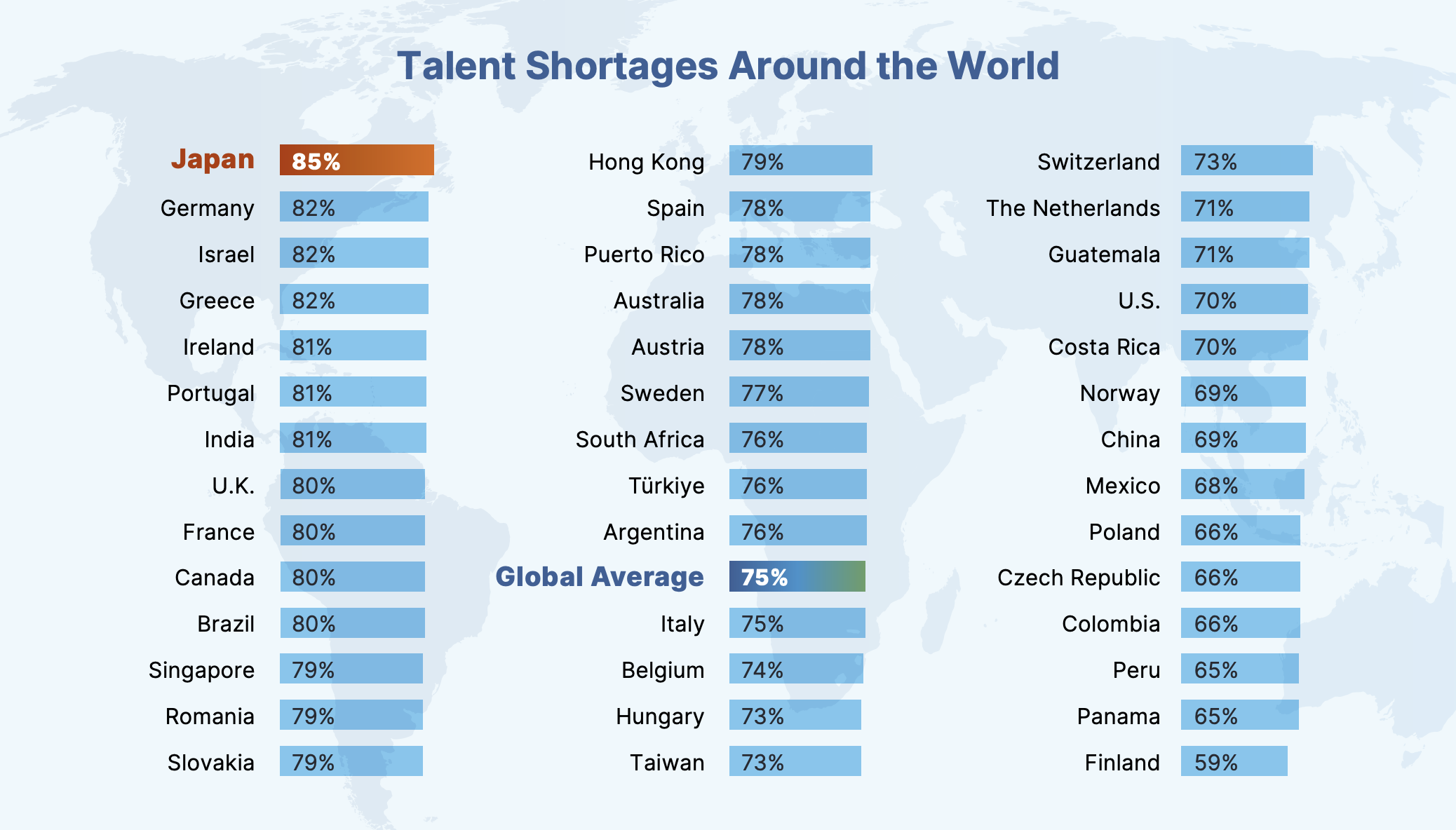Blog
Talent Shortage on Japan's Tech Industry
Talent Shortage on Japan's Tech Industry
Japan's faces a severe talent shortage, with 85% of employers struggling to fill roles, the highest rate globally. The demand for developers is particularly high, driven by the competitive tech landscape. Traditional recruitment processes, which are time-consuming and costly, exacerbate the challenge, especially in finding niche or emerging skills. To remain competitive, companies must rethink their recruitment strategies, focusing on reskilling, enhancing engagement, and optimizing the workforce to address the ongoing talent shortage.
Written by
Ariadne Mavrogenis
Last updated
AUG 13, 2024
Topics
#business
Length
7 min read

The high demand for developers and the competitive nature of the tech landscape require companies to rethink their traditional recruitment and retention approaches.
Today, 75% of employers worldwide report difficulty filling roles. In Japan, this figure is the highest globally at 85%, which is 10% above the global average. In the information technology industry, this percentage is also higher than the average at 76%, according to a 2024 Global Talent Shortage research report.


The situation is further complicated by traditional recruitment processes, which are time-consuming and costly, making it particularly challenging to find individuals with niche or emerging skills. This challenge is exacerbated by the limitations of traditional long-term contracts. As the 2024 State of Tech Talent Japan Report highlights, Japanese organizations typically take 12 months to hire and onboard employees, with a high turnover rate of 47% within six months of onboarding.
In 2023, Lionel Kaidatzis, Managing Director at Morgan McKinley Japan, said, “The technology talent landscape in Japan was highly competitive throughout 2023, making it difficult for businesses to find skilled professionals. With fewer headcounts, companies have raised the bar on the quality of talent they want to hire, which has made hiring top talent even more competitive given the ongoing shortage. With skilled professionals receiving multiple offers, employers have had to shorten their time to release offers to entice top candidates. Even a few days of delay could be the difference between hiring talent and losing out to competitors.”
Although the technology talent landscape improved in 2024, there is still a high demand for skilled professionals, especially in software development.
As highlighted in the Japan 2024 Job Market Report: “Software developers are in high demand, given the continued growth of the technology sector. These professionals create, maintain, and optimize software applications for various industries. Their skills in programming languages and software development tools make them essential in an increasingly digital world.”
With a shortage of developers, high demand for those available, and traditional hiring processes faltering, companies must implement radical changes to remain competitive. HR professionals in Japan need to adopt strategic initiatives to address the talent shortage. They should focus on reskilling, enhancing engagement, and optimizing the workforce. In this article, we will explore key strategies tailored to the Japanese context, helping HR professionals unlock their employees' full potential and drive organizational growth.
A Holistic Talent Strategy
Given the complexity of the problem, it is important to approach it from several angles. It is not enough to change one thing; rather, a number of small and large changes to the current system are necessary. To keep pace, an effective talent strategy should comprise a mix of four key elements:
1. Build: Invest in learning and development to grow your talent pipeline
Beyond the basic benefits, an important aspect to consider is a company’s support for skill development. Workforce development is crucial for any organization aiming to stay competitive and relevant in today’s market. Investing in learning and development to grow your talent pipeline is essential. A popular approach to workforce development is the skills approach for talent pipeline and learning & development, which focuses on enhancing employee skill sets to boost productivity and efficiency.
Companies should create robust training programs and opportunities for continuous learning to ensure employees can acquire new skills and adapt to evolving industry demands.
Skill support can come in many forms, such as covering the cost of books and learning materials, organizing training events, or supporting employees to attend external job-related events. Some companies even go as far as to support employees in obtaining advanced degrees, including Ph.D. programs. Additionally, you can gain valuable real-life experience by learning from other companies during collaborative projects. This hands-on experience provides insights beyond theoretical knowledge, helping employees grow and apply new skills in practical settings.
2. Buy: Go to the external market to attract talent that can’t be built in-house
Japan’s population of 126 million is rapidly aging and shrinking, and many short-staffed industries have already started to rely heavily on foreign talents. Although Japan has been opening up to hiring foreigners over the past few years, Japanese companies need to take the necessary measures to attract and retain talented individuals. For example, they need to make their companies more foreigner-friendly. Not only do they need to create a culture that allows foreign talent to feel comfortable, but they also need to solve the language barrier problem. They need to ensure they hire people who are comfortable with Japanese culture.
Given the high talent shortage, it is important that Japan is open to hiring foreign workers. If it’s difficult to find the right candidates with the right skills or expertise locally or even within the country, opening the doors to global talent provides a wider talent pool and better chances of finding the ideal candidate with the hard or soft skills needed for the job.
Sometimes, the skills needed are so specific or advanced that external recruitment is the best option. Companies should have a proactive recruitment strategy to identify and attract these high-caliber professionals.
3. Borrow: Cultivate communities of talent outside the organization
Cultivate talent communities outside the organization. Working with freelancers, entrepreneurs, and other external talent enables companies to access specific skills and fill gaps without the long-term commitment of traditional recruitment. There are a growing number of market players who are engaging in Team Augmentation alongside their normal operations. It is worth contacting such firms that can facilitate the sourcing of talent.
What is Team augmentation:
The Team Augmentation model is a strategic approach that enables companies to efficiently expand their teams, for example, their development teams, on a project basis without the need to hire permanent employees. The essence of this model lies in leasing selected developers tailored to the needs of a specific project, who temporarily join the existing team and contribute to the project's success.
In the operation of this model, companies typically enter into contracts with an external service provider or development company, wherein they define the necessary developer resources and skills for the project. Subsequently, the service provider is responsible for selecting and providing the appropriate developers for the project.
This model is already widely practiced in many other countries and has brought significant benefits to companies. For example, numerous technology and software development companies in the United States and the United Kingdom successfully employ this model to respond more quickly and effectively to market demands. Additionally, there is a growing trend of project-based developer collaborations in several European countries, as well as increasing adoption in Asian countries. Specifically, in Japan, this trend is starting to become more favorable year by year, as an increasing number of large Japanese companies recognize the benefits of the model and exploit them to grow and maintain their competitive position.
4. Bridge: Help people move on or move up to new roles within the organization
It is not enough to simply buy new talent; you need to properly integrate them into your company to ensure they are productive and aligned with your organizational goals. This also applies when you borrow talent. Integrating borrowed talent, even on a project basis, is crucial for maximizing their contributions and ensuring seamless collaboration.
Proper integration involves several key steps:
- Onboarding: Familiarize new hires with the company's mission, values, and culture to help them understand their role.
- Training: Provide necessary training and development opportunities for skill growth.
- Mentorship: Assign mentors to guide new employees through company culture and processes.
- Communication: Establish open communication channels and regular check-ins to address concerns early.
- Cultural Integration: Foster an inclusive culture, especially for international hires, through social interactions and team-building.
- Remote Work Support: Equip remote employees with the tools and support they need to collaborate effectively.
- Performance Management: Set clear expectations, provide feedback, and recognize achievements.
By focusing on these integration strategies, companies can ensure that new and borrowed talent contribute effectively, feel valued, and stay committed to the organization. This approach not only enhances productivity but also helps in retaining top talent in the long term.
Conclusion:
The talent shortage in Japan's tech industry presents a formidable challenge, underscoring the necessity for innovative and multifaceted strategies to attract, develop, and retain skilled professionals. The high demand for developers and the competitive nature of the tech landscape require companies to rethink their traditional recruitment and retention approaches. By adopting a holistic talent strategy that includes building internal capabilities through robust training programs, attracting foreign talent to fill specific skill gaps, leveraging external talent through team augmentation, and ensuring seamless integration of new hires, companies can navigate the complexities of the talent shortage. These strategic initiatives not only help in addressing immediate talent needs but also foster a sustainable and competitive workforce for the future. In embracing these comprehensive solutions, Japanese tech companies can unlock the full potential of their employees, drive organizational growth, and maintain their competitive edge in the global market.
Scriptide is a highly skilled software development company that specializes in custom, complex B2B software solutions. We offer a wide range of services, including digital transformation, web and mobile development, AI, blockchain, and more.
Get a free IT consultation. We are excited to hear from you.
You might also like these articles!
Click for details
From Market to Partner: Insights from Scriptide’s Founders on Japan
Scriptide has been active in the Japanese market for five years. Following their latest business trip to Japan, we spoke with CEO Daniel Fazekas and COO Tamas Fazekas, the company’s founders, about their experiences, impressions of Japanese business culture, and why they see Japan as such an important market. During their stay, they attended the Japan–Hungary Business Forum, visited the Novare Innovation Center, and explored the site of the upcoming World Expo in Osaka.
#business
•
OCT 03, 2025
•
8 min read
Click for details
Why You Should, and Shouldn’t Use AI in Software Development? - Through the Lens of a Tech Agency Lead
Artificial intelligence is becoming an increasingly common presence in the software development world. Tools that generate code, suggest optimizations, or even automate test creation promise faster delivery and reduced effort. For many teams, it feels like a productivity dream come true. But as with any technological shift, it’s worth pausing to ask: What happens when we rely too much on AI? And more importantly, can AI truly replace software developers?
#business
•
MAY 27, 2025
•
5 min read